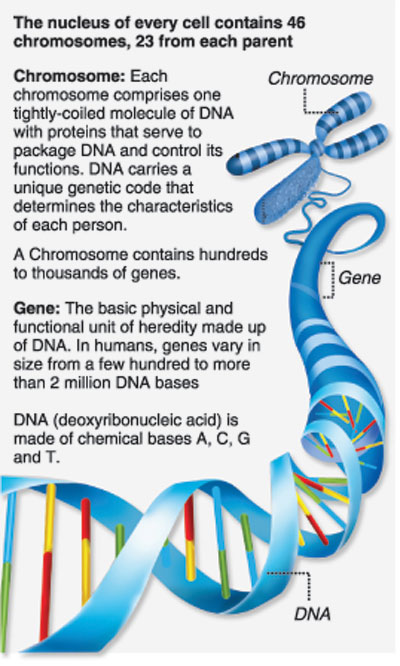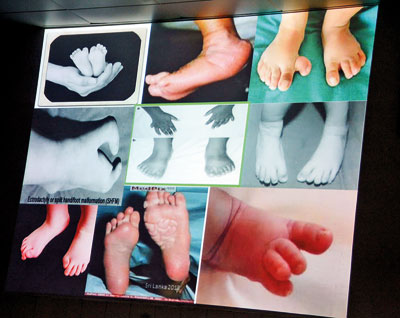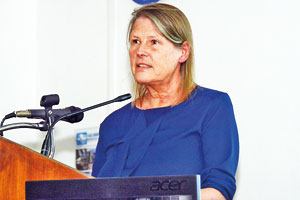Learning to deal with ‘rare diseases’
Numerous are the issues and challenges faced in this particular sphere of medicine –diseases that are found in few and far between children and the stigma surrounding them. It is through the eyes, ears and experiences of Prof. Harendra de Silva who is Chairman of the Rare Diseases Forum of the Sri Lanka College of Paediatricians that MediScene gets a glimpse of the hardship faced by parents who care for these children.
 A ‘rare’ disease affects 1 in 2,000 or fewer and does not include infectious diseases, says Prof. de Silva using the European definition. There are about 7,000 identified as rare diseases. Pointing out that most of the rare diseases, around 80%, have a genetic background, he groups them into two broad categories – chromosome disorders and inherited metabolic disorders.
A ‘rare’ disease affects 1 in 2,000 or fewer and does not include infectious diseases, says Prof. de Silva using the European definition. There are about 7,000 identified as rare diseases. Pointing out that most of the rare diseases, around 80%, have a genetic background, he groups them into two broad categories – chromosome disorders and inherited metabolic disorders.
n Chromosome disorders – these come about when there is a change in the regular number of chromosomes or there is a change in the structure of the chromosomes. The most severe chromosome disorders are caused by the loss (deletion) or gain (addition) of whole chromosomes.
n Inherited metabolic disorders – these are the result of a defective gene which leads to an enzyme deficiency. Next, Prof. de Silva focuses on a few rare diseases.
n Cystic Fibrosis – Causing severe damage to the lungs, digestive system and other organs in the body, this disease affects the cells that produce mucous, sweat and digestive juices. Explaining that those suffering from this disease have higher-than-normal levels of salt in their sweat, he says that usually mucous, sweat and digestive juices are thin and slippery. However, in those with cystic fibrosis, these secretions are sticky and thick.
These secretions without acting as lubricants tend to block tubes, ducts and passageways particularly in the lungs and the pancreas.

A slide from the presentation on rare diseases by Dr. Liesbeth Siderius
When the lungs are affected there is a persistent cough that produces thick sputum, wheezing, breathlessness, exercise intolerance, recurrent lung infections and inflamed nasal passages and a blocked or stuffy nose. When digestive enzymes get blocked out digestion and absorption of food is affected causing foul-smelling, greasy stools, poor weight gain and growth, intestinal blockage (in newborns meconium plugs) and severe constipation.
According to Prof. de Silva among Caucasians the prevalence is about 1 in 2,500 while there are fewer than 10 reported cases in Sri Lanka.
n Glycogen Storage Disorder – When a child is affected by this disorder, the liver cannot control the use of glycogen and glucose as certain enzymes are missing that control the change of sugar (glucose) into its storage form (glycogen) or release of glucose from glycogen.
Prof. de Silva says that the body uses many sugars, including glucose, in foods as a source of energy. While the blood glucose levels rise after a meal, the body stores any extra glucose that is not needed immediately, as glycogen in the liver and muscles. This stored energy or glycogen comes in handy later, when the blood glucose levels in the body begin to drop.
But to process the glycogen, there are enzymes. The problems arise when these enzymes are missing and the glycogen builds up in the liver.
According to him there are different types of this disorder, depending on which particular enzyme is affected. n Phenylketonuria or PKU – In this condition, a substance known as phenylalanine rises in the blood. Phenylalanine is a building block of proteins (an amino acid) obtained from the food (all proteins and some artificial sweeteners) a child eats.
If not treated, the child will have sei -zures, tremors or trembling and shaking and mental retardation; stunted growth; hyperactivity; skin conditions such as eczema; and a musty odour on his/her breath, skin or urine.n Gillespie Syndrome — Eye abnormalities, balance issues and coordinating movements (ataxia) and mild to moderate intellectual disability could all be signs of this syndrome. A major characteristic is the lack of the coloured part (iris) of the eye which is called aniridia. In some, part of the iris may be missing (partial aniridia) in both eyes, while in others partial aniridia may affect only one eye. There can also be patients with the entire iris missing (complete aniridia) in one or both eyes.
This is an “extremely rare disorder”, says Prof. de Silva, pointing out that 1 case has been reported in Sri Lanka and 25 around the world.
Battling for diagnosis, better health and social careStressing that all children have equal rights, the Coordinator of the Rare Disease Working Group of the European Academy of Paediatrics, Dr. Liesbeth Siderius pointed out that unfortunately there are many health inequalities among children. Some of the issues they face are battles for diagnosis and also inadequate health and social care.  Dr. Liesbeth Siderius. Pic by M.D. Nissanka Addressing the tightly-packed auditorium of the Lady Ridgeway Hospital (LRH) for Children in Colombo on ‘The clinical approach to children with rare diseases’ during a recent visit to Sri Lanka, she said that these illnesses may be rare for us doctors but they become common for the parents who have such a child. The rare diseases are mostly genetically-oriented and life-threatening, MediScene learns. This is why it is crucial to identity children with rare diseases through primary health care programmes, child health surveillance and vaccination programmes. Pointing the way how to find a child with a rare disease, she says that pregnancies and births could be monitored, keeping an eye out for congenital anomalies and heel-stick screening and hearing and visual screening could be conducted. Rare diseases seriously impact everyday life, says Dr. Siderius giving some disturbing data:
Before dealing with some rare diseases, she says that it is important not only to take the family history but also the history of pregnancy while keeping track of developmental and physical milestones. “In many cases there is no need for expensive tests, a good clinical examination will point the way.” Dr. Siderius zeroes-in on more rare diseases mostly found in Europe. Some of these are rare in Sri Lanka or have not been described yet from the country which, however, does not mean that there are no cases: n Fibrodysplasia Ossificans Progressiva – This is a disorder in which bone gradually replaces skeletal muscle and connective tissue including tendons and ligaments. It leads to the formation of extra-skeletal bone which in turn restricts movement. A symptom would be abnormal toe flare-ups. n Rett Syndrome – Causing developmental and nervous system regression only in girls, it is X-linked dominant and lethal to boys. This syndrome has some features of autism. Although baby-girls affected by this syndrome seem to grow and develop normally between three months and three years of age, they become progressively unable to use muscles for eye and body movements and speech. n Sickle Cell Disease – With the red blood cells taking the shape of sickles, they prevent the flow of blood by blocking the blood vessels. This hinders the transport of essential oxygen to the different parts of the body. This disease is more prevalent among African populations living in Europe. It does exist in Sri Lanka but Thalassaemia (which we will feature separately at a future date) is a more common blood disease here. With regard to seeking a second opinion, Dr. Siderius urges doctors to “ask the computer”, for now books have disappeared but the internet has all the answers. | |


